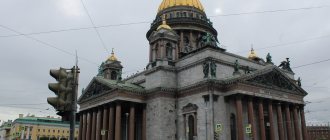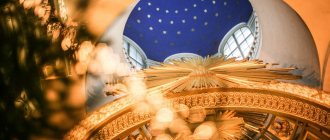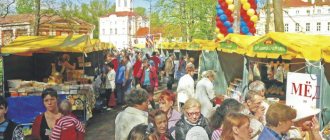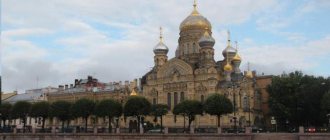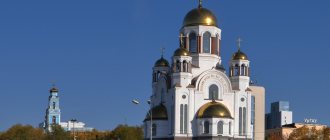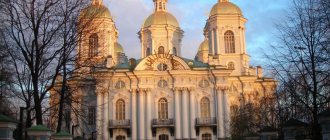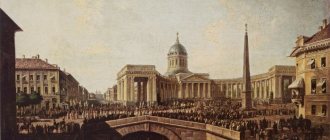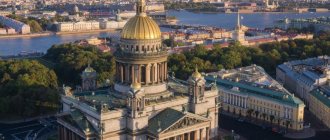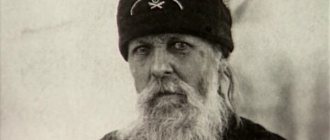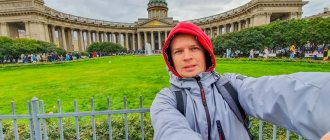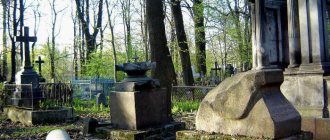Review of the newspaper “Orthodox St. Petersburg”
How often do we, in the chaos of everyday life, in the bustle of political, financial and all other passions, forget that the ground we walk on is holy. Holy Russian land... And there are so many shrines here that the whole place is like a large, bright, skillfully decorated temple. The November issue of the newspaper “Orthodox St. Petersburg” reminds its readers of one - just one and many thousands - of such a shrine - the miraculous icon of St. VMC. Paraskeva, which is now kept in the Alexander Nevsky Lavra, but was originally revealed in the small village of Ilyeshi, several tens of kilometers from St. Petersburg. A longtime newspaper author, Fr. Leonid Trofimuk. We do not give his entire story here, just these words:
- ...The saint - he makes sure that you are healthy spiritually, and for this you need just everyday inconveniences. If, by the will of God, you come close to a saint, tighten your belt: asceticism awaits you - and not far-fetched, but real, the kind that you never wanted. I didn’t want it, but I got it. They told me this story. A certain young believing woman greatly revered Saint Paraskeva. One day she had to go through an important interview at work, and it fell on St. Valentine’s Day. Paraskeva. Confident that the saint would help her, the woman was not particularly worried. And suddenly, a few minutes before the start of the interview, she decided to drink coffee - and accidentally spilled the entire cup on her dress! That's it, it's over! You can't change your clothes anymore! What should I do? And she bitterly complained about her beloved saint: “Ah, Paraskeva, Paraskeva! On your day, you could have saved me from such trouble!” But what can you do? You need to go for an interview! She wrapped herself in some rags that came to hand, and so she went... And she passed the interview perfectly! And then she realized what was going on here: she had to think not about how to show off, how to look more impressive in the eyes of the examiners, but on the contrary, try to get less attention paid to her person, so that the examiners would not think about her, but about what does she say.
The interview with Father Leonid is called “YOU CHOOSE A SAINT - THE SAINT CHOOSE YOU.”
But the story is not about a saint, but simply about a good, kind, hardworking woman - Mother Natalya, the wife of the rector of the church in the name of the Great Church. Barbarians in the village Rakhya of priest Oleg Patrikeev. The correspondent asked my mother:
— Raising children is not an easy task. How do you cope with six?
“I cope because I do it myself, I don’t trust strangers—teachers in nurseries and kindergartens.” How can I understand my child, how can I help, if I don’t see him all day, I don’t know what he thinks, why he did something? I don’t even go to the playground with my younger ones - there mothers treat their children so rudely, using swear words... But my children do not sit at home, confined within four walls. They practice drawing, music, figure skating, and horse riding. Vasilisa (she is currently studying in the 6th grade), for example, is ready to spend days and nights at the children's equestrian academy "Rutenia", especially since there is a petting zoo nearby, where goats, chickens, rabbits live... And at home we have three dogs and two cats. Vasilisa dreams of becoming a veterinarian. Alice entered Peking University, studying Chinese and English. The eldest Valeria is studying at a medical institute, and ninth-grader Varvara wants to follow in her footsteps when she graduates from school. Seraphima is engaged in figure skating and studies in the second grade of a private Orthodox school, where, in addition to general education subjects, our dad teaches the Law of God. The youngest son, Georgy, does not go to school yet, he is small.
The story about Mother Natalya is called “THERE IS SUCH A PROFESSION – MOTHER.”
The topic of a properly arranged family life is developed in his own way by the long-time author of our newspaper, Rev. Dimitry Vasilenkov:
— Of course, justice is needed, moreover, it is absolutely necessary, but it must extend to the entire society, not only to the elite. Our entire society is sick. Evidence of this: the number of abortions. How many abortions occur in Russia per year? I heard that in St. Petersburg alone there are more than 100 thousand. And who makes them? Our Russian women! Not the migrant women, legal and illegal, who live in our cities - they are the ones giving birth. And Russian women have abortions! And it’s not that especially the poor do this, but people, as a rule, are wealthy. The child-free ideology is being implanted among our youth, among our own children, but why do people accept this ideology? Because they like serving the golden calf more than serving the Fatherland, family, new generations - God, ultimately. This does not apply to just the elite, but to all of us. And there are many, many similar problems that are destroying both our society and our elite. Everyone is sick - from top to bottom. Yes, insults - and just ones! - enough! Enough to set everyone off in a dashing revolutionary mess, in a bloody madness. And everyone who starts this mess, everyone who gets involved in it, will be right in their own way: an insult is an insult. There is only one problem: we forget who benefits from our turmoil.
Interview with Fr. Dimitry Vasilenkov calls it “MAMONA—RUSSIA’S WORST ENEMY.”
Our other regular author, Doctor of History, also speaks about the troubles of modern Russia. Sciences, Protodeacon Vladimir Vasilik. He discusses whether the Church should somehow respond to the monstrous number of car accidents that occur on our roads. He says:
- Yes, I should. And above all, strict church reprimands against corrupt officials. Of course, those who commit outrages on the roads, those who drive drunk, those who violate traffic rules - they are guilty. The rules of the road are written in blood, just like the holy canons. But those who release these rioters onto the road are much more guilty. These are traffic police inspectors, and indeed the entire current road inspection system, built on monstrous corruption. The criminal, first of all, is the one who shelters and covers these lawless people - he sells human blood for despicable money; someone who doesn’t take away bad drivers’ licenses, who doesn’t care about proper driver training, who lets incompetent and ambitious fools onto the road for money. And at the same time, real, experienced drivers are tormented by countless re-examinations!.. It’s no secret that now it’s completely impossible to get a license without a bribe. And the Church must respond to this with the strictest punishments, up to and including the threat of excommunication from the Church of malicious corrupt officials! And even - in especially serious cases - deprivation of their church burial. No matter how harsh it sounds, people who have blood on their hands should not even be remembered in the Church. “I will not gather their councils from bloodshed,” the psalm says, “neither will I remember their names in my mouth” (Ps. 15:4). The Church must say, together with the Apostle Paul: “Therefore I testify to you this day that I am clean from the blood of all” (Acts 20:26). If such a moral court existed in the Church, its judgment would sound really strong and worthy - otherwise we, church people, often find ourselves in the position of guilty boys, and every time a priest does something wrong on the road, the whole Church is disgraced because of this , because of this, all the media are rinsing it, even despite the fact that all canonical punishments are immediately taken against the guilty priests - but somehow all this is immediately forgotten by the world. No, the Church must definitely speak out on the problem of corruption in the authorities supervising roads.
Speech by protodiac. Vladimir Vasilik is called: “MRS CAR”.
But the story is simple, uncomplicated, but instructive. It tells about schoolchildren from a small Russian town who skated on a frozen river in winter. A mother talks about her son named John:
- It happened that John would come running home without a jacket, wearing only sweatpants: “Mom! I gave away my jacket and trousers. There the boy fell into the water. He’ll bring it in later.” Or it was that John himself would come later: “I’m here alone, he fell into the water, I helped him get home.” And he himself was dry all the time, and never got wet on the river. "Why?" — I thought. The local boys know the river like the back of their hand, but John doesn’t know the river at all. I was interested, but kept quiet. I'm waiting for the matter to clear up on its own. And John could not stand it. He was walking another loser home, and he said to me: “Mom, have you noticed that I’ve been on the river every day for almost a month now, and I’ve never come home wet?” “I noticed,” I say. - “Why is this, do you know?” - “Tell me, son, it’s interesting.” - “And I, Mom, mentally read the prayer “Living Help” when I’m running on the river with the guys. Somebody gets “bathed”, but I don’t. Prayer protects me. Listen, what a miracle it was today. The guys and I ran a race. I overtook almost everyone, only one ran in front of me, I was breathing right down his back. I thought I would overtake him at the river turn. And suddenly our leader fell into the wormwood... I didn’t have time to understand anything. Only he was before my eyes, and suddenly, he was gone. And instead there is black water, and I walk on the water as if on ice. The two behind me suddenly braked. The first one is floundering in the water, the guys are standing on the ice by the water, and I am on the other side of the ice hole. Ask anyone you want. Our guys saw all this.
This story is called: “ON A FROZEN RIVER.” We hope that other materials from the November issue of the newspaper “Orthodox St. Petersburg” will also interest our readers and bring them spiritual benefit.
LiveInternetLiveInternet
Quote from Matrioshka
Read in full In your quotation book or community!
Orthodox cathedrals of St. Petersburg. Part 1. Temples and cathedrals of St. Petersburg are an integral part of the history of the city. Since its inception, St. Petersburg has been an important cultural center of Russia; there are world-famous museums, theaters, palace and park ensembles, churches and cathedrals of St. Petersburg, which in turn are not only of cultural and historical interest, they serve as spiritual centers of the Orthodox faith , which is being revived again in our time.
An Orthodox cathedral in Orthodoxy is a temple (church), which in its significance and fame is significantly superior to other Orthodox churches and therefore enjoys special respect among believers. Orthodox cathedrals in St. Petersburg are cathedrals belonging to the Orthodox religious denomination and located within the administrative boundaries of the territory called the urban area of the same name.
Among the Orthodox churches in St. Petersburg, 19 of the largest have the status of cathedrals. All these buildings are architectural monuments and play the role of important urban landmarks in the panorama of the city. Many of them are also monuments of military glory. Orthodox cathedrals of St. Petersburg are located mainly in its historical center - on the Admiralty side they are the Peter and Paul Cathedral, the Kazan Cathedral, the St. Nicholas Naval Cathedral, the Spaso-Preobrazhensky and the Trinity-Izmailovsky Cathedrals, the Holy Cross Cathedral on Ligovsky Prospekt, as well as St. Isaac's Cathedral (which is a state museum; the service is performed in one of the chapels of the cathedral); On Vasilievsky Island there is St. Andrew's Cathedral, and on the Petrograd Side there is the Prince Vladimir Cathedral. On the Vyborg side there is Sampsonievsky Cathedral, one of the oldest churches in St. Petersburg. The Church of the Vladimir Icon of the Mother of God on Vladimirskaya Square, included in this list, received cathedral status only in 2000. The Cathedral in the name of the Feodorovskaya Icon of the Mother of God, which was converted into a dairy factory during Soviet times, is being restored. The Smolny Cathedral is currently not operational and performs exhibition and concert functions. The number of St. Petersburg cathedrals also includes churches located in the outskirts and suburbs of St. Petersburg, which are now part of the city. These are the Ascension (Sophia) Cathedral and Theodore Sovereign Cathedral in Tsarskoye Selo (Pushkin), the Cathedral of St. Nicholas the Wonderworker in Pavlovsk, Cathedral of Sts. App. Peter and Paul in Peterhof, the Cathedral of the Archangel Michael in Lomonosov, as well as two churches in Kronstadt - the Cathedral of the Vladimir Icon of the Mother of God and the St. Nicholas Naval Cathedral.
Peter and Paul Cathedral (Cathedral in the name of the Supreme Apostles Peter and Paul)
The Peter and Paul Cathedral occupies a special place in the ensemble of the Peter and Paul Fortress. In 1703, almost simultaneously with the construction of earthen fortifications, a small church was erected on Hare Island, founded in the name of the apostles Peter and Paul. In 1713, construction of a cathedral began in its place according to the design of the architect D. Trezzini, completed by 1733. On June 28, 1733, the Peter and Paul Cathedral was solemnly consecrated.
In 1756, the cathedral caught fire from a lightning strike; the spire and the chimes installed on it were especially damaged. Only 20 years later the cathedral was again decorated with clocks made by the Dutch master O. Crass.
Every hour they played the tune of the national anthem. During the restoration work, the proportions of the Peter and Paul Cathedral were slightly changed: the size of the dome was reduced and the shape of the roof was simplified. A hundred years later, in 1857-1858, the wooden structures of the cathedral were replaced by metal ones, made by the architect D. Zhuravsky.
Peter and Paul Cathedral is the tallest architectural structure in St. Petersburg. It is decorated with a gilded spire 122.5 meters high, which is crowned with a weather vane in the form of a flying angel. In 1829, the weather vane was damaged by a strong storm.
At that time, there was no money in the treasury for the construction of special scaffolding for restoration work, and then the roofer Peter Telushkin undertook to correct the angel, climbing to the top of the spire with the help of only a rope. For his courage, the emperor granted Telushkin the right to drink in any tavern in the Russian Empire at the expense of the state treasury, and the people nicknamed him “Heavenly Roofer.” Already today, in the 90s of the 20th century, restorers completed the work of correcting the angel with the help of helicopters.
The interior of the cathedral resembles the ceremonial hall of a palace. Marble-painted pylons divide it into three naves. The picturesque paintings on the walls were made by A. Matveev, G. Gzel and other famous artists.
The carved iconostasis in the form of a triumphal arch stands out with its bright gilding, lightness and grace of lines and shapes - a masterpiece of Baroque decorative art, created according to the design of I. Zarudny in 1722-1726. The icons for the iconostasis were made by the Moscow master A. Pospelov.
Opposite the altar is a magnificent gilded pulpit, decorated with statues of the two Apostles. Symmetrically located to it is the Royal Seat, decorated with a carved gilded crown and crimson velvet with a double-headed eagle embroidered on it. Funeral services were held in the cathedral in the presence of members of the imperial family. The shrines of the temple include the image of St. Apostle Peter, painted by Simon Ushakov.
The cathedral, which became a monument to Russian military glory, housed the spoils of war of the Russian army, including such relics as Swedish banners and standards taken at Poltava and during other battles during the Northern War.
Cathedral bell tower carillon
The Peter and Paul Cathedral served as the tomb of Russian monarchs. All Russian tsars of the Romanov dynasty are buried here, with the exception of Peter II and Ivan VI. The founder of the city, Peter the Great, is buried near the southern wall of the cathedral. The unique tombstones of Alexander II and his wife Maria Alexandrovna, different from other tombstones in the tomb, are made of gray-green Altai jasper and pink Ural eagle. The last burial in the Peter and Paul Cathedral took place in the summer of 1998, on the 80th anniversary of the execution of Nicholas II, his wife Alexandra Feodorovna, their children and servants. The last Russian emperor and his family were buried in the Catherine's chapel of the Peter and Paul Cathedral.
Karl Osipovich Brozh. Funeral of Alexander III in the Peter and Paul Cathedral in St. Petersburg
Kazan Cathedral (Cathedral of the Kazan Icon of the Mother of God)
Kazan Cathedral (Cathedral of the Kazan Icon of the Mother of God) is one of the largest churches in St. Petersburg, made in the Empire style. Built on Nevsky Prospekt in 1801-1811 by the architect A. N. Voronikhin to store the revered copy of the miraculous icon of the Mother of God of Kazan.
After the Patriotic War of 1812, it acquired significance as a monument to Russian military glory. In 1813, commander M.I. Kutuzov was buried here and the keys to the captured cities and other military trophies were placed.
The interior of the Kazan Cathedral is designed as a majestic three-nave columned hall. Marble, porphyry, jasper and Finnish granite are widely used in the interior decoration of the cathedral. Outside and inside the cathedral is decorated with sculpture created by the best Russian masters such as Pimenov, Martos, Demut-Malinovsky and others.
External bronze sculptures represent Saints Vladimir, St. Andrew the First-Called, John the Baptist and Alexander Nevsky.
In 1932 it was turned into the Museum of the History of Religion and Atheism; since 1991, the operating temple coexisted with the museum’s exhibition for several years. Since 2000 - the cathedral of the St. Petersburg diocese of the Russian Orthodox Church.
St. Nicholas Naval Cathedral (Naval Cathedral of St. Nicholas the Wonderworker and Epiphany) [
Nikolskaya Square, on which the St. Nicholas Naval Cathedral is located, was planned in the first half of the 18th century by the architect P. Eropkin. Previously, this place was the site of the Marine Regimental Yard. Perhaps the initiator of the creation of the St. Nicholas Cathedral was Peter I himself: information has reached our days according to which the tsar was fascinated by the Naval Cathedral in Astrakhan and wished that St. Petersburg would be decorated with a similar architectural masterpiece. However, construction of the cathedral began only under Peter’s daughter, Empress Elizabeth, and ended under Catherine II, in 1762. The cathedral was built according to the design of the architect S. Chevakinsky in the “Elizabethan Baroque” style. It became a temple-monument to Russia's naval glory: Catherine the Great ordered that ten icons be given to it in memory of Russian naval victories over the Turkish and Swedish fleets.
The cathedral symbolizes the inextricable unity of the sublime and the earthly: the mundane volume of the temple is in perfect harmony with the high bell tower.
St. Nicholas Cathedral, decorated with 68 columns of the Corinthian order, is painted blue and richly decorated with white stucco. The temple is crowned with five domes covered with gilding.
St. Nicholas Cathedral consists of two churches - lower and upper. The lower church is consecrated in the name of St. Nicholas the Wonderworker of Myra, who is considered the patron saint of all travelers, including by sea.
Icon of St. Nicholas the Wonderworker
The upper church was consecrated in the name of the Epiphany of the Lord, hence the full name of the temple - St. Nicholas Cathedral. In the upper church, a magnificent carved iconostasis by master I. Kanaev has been preserved. On the iconostasis there are icons made in the Byzantine tradition by the Kolokolnikov painters. The main shrine of St. Nicholas Cathedral is the icon of St. Nicholas the Wonderworker, dating back to the 17th century.
Spaso-Preobrazhensky Cathedral (Cathedral of the Transfiguration of the Lord of All Guards)
The temple was erected by order of Empress Elizabeth Petrovna on the site of the retreat hut (headquarters) of the grenadier company of the Life Guards Preobrazhensky Regiment in memory of the Empress’s accession to the throne with the help of soldiers and officers of this regiment.
On August 5, 1754, the church, built according to the design of M. G. Zemtsov and rebuilt according to the design of P. A. Trezzini, was consecrated.
After a severe fire that broke out on August 8, 1825, the architect V.P. Stasov, using old walls, restored the cathedral, giving it an empire look. The cathedral was re-consecrated on August 5, 1829.
In 1830 - 1833, a fence made from captured Turkish cannons was built around the cathedral according to Stasov’s design. The Bulgarians who lived in the city celebrated their holidays in this cathedral.
After the revolution, the temple remained operational, and during the Leningrad siege, a bomb shelter for 500 people was built in its basement, where the wounded were treated.
Trinity-Izmailovsky Cathedral (Cathedral of the Holy Life-Giving Trinity of the Life Guards Izmailovsky Regiment)
Trinity-Izmailovsky Cathedral is one of the largest monumental churches in St. Petersburg. Its bright blue domes can be seen from a distance of 20 km from the city. The cathedral was erected by the architect V. Stasov in 1828-1835 in honor of the Life Guards Izmailovsky Regiment, one of the oldest in Russia. Founded by Empress Anna Ioannovna in 1730 and named after the village of Izmailovskoye near Moscow, the regiment took part in many battles that were decisive for the Russian Empire. The barracks of the Izmailovsky Regiment were located where Krasnoarmeyskie streets are today.
One of the most revered shrines of the Trinity-Izmailovo Cathedral is the icon of the Holy Trinity, painted in the 15th century. The sacred image of Byzantine writing was removed from the Moscow Tretyakov Gallery in 1932 and sold abroad to one of the private collections. Already today, the icon was bought at an auction in Switzerland and returned to Russia. Prayers are served daily at the Holy Trinity Cathedral at the shrine.
| Categories: | Cityscape Photo Traditions. From history... The most interesting places on the planet. Temples, cathedrals, mosques, churches |
Tags:
photographs temples cathedrals from history city landscape the most interesting places on the planet St. Petersburg Orthodox cathedrals of St. Petersburg
